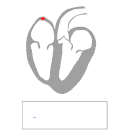Cardiac conduction system
Cardiac Conduction System
The Cardiac conduction system is a complex network of specialized cardiac muscle cells that initiate and coordinate the contraction of the heart muscle. This system ensures that the heart beats in a coordinated and effective manner, thereby facilitating efficient blood flow throughout the body.
Structure[edit]
The cardiac conduction system consists of several key components:
- The Sinoatrial node (SA node), often referred to as the heart's natural pacemaker, initiates each heartbeat and determines heart rate.
- The Atrioventricular node (AV node) slows the electrical signal before it enters the ventricles, allowing the atria to contract before the ventricles.
- The Bundle of His, a pathway that transmits the electrical signals from the AV node to the ventricles.
- The Purkinje fibers, which spread the electrical impulse throughout the ventricles, causing them to contract and pump blood.
Function[edit]
The cardiac conduction system controls the heart rate and rhythm. The SA node generates an electrical impulse that spreads through the atria, causing them to contract and pump blood into the ventricles. The electrical impulse then reaches the AV node, where it is delayed before being transmitted to the ventricles through the Bundle of His and Purkinje fibers. This delay allows the ventricles to fill with blood before they contract.
Clinical significance[edit]
Disorders of the cardiac conduction system can lead to arrhythmias, or irregular heart rhythms. These can range from harmless to life-threatening. Some common arrhythmias include atrial fibrillation, ventricular tachycardia, and heart block. Treatment options for arrhythmias include medication, cardiac ablation, and the implantation of a pacemaker or implantable cardioverter-defibrillator (ICD).
See also[edit]
References[edit]
<references group="" responsive="1"></references>

This article is a cardiovascular system stub. You can help WikiMD by expanding it!
-
Cardiac conduction system
-
Basic representation of cardiac conduction
-
Conduction system of the heart without the heart
-
Shapes of the cardiac action potential in the heart
-
ECG intervals
-
ECG principle
Ad. Transform your life with W8MD's Budget GLP-1 injections from $75


W8MD offers a medical weight loss program to lose weight in Philadelphia. Our physician-supervised medical weight loss provides:
- Weight loss injections in NYC (generic and brand names):
- Zepbound / Mounjaro, Wegovy / Ozempic, Saxenda
- Most insurances accepted or discounted self-pay rates. We will obtain insurance prior authorizations if needed.
- Generic GLP1 weight loss injections from $75 for the starting dose.
- Also offer prescription weight loss medications including Phentermine, Qsymia, Diethylpropion, Contrave etc.
NYC weight loss doctor appointmentsNYC weight loss doctor appointments
Start your NYC weight loss journey today at our NYC medical weight loss and Philadelphia medical weight loss clinics.
- Call 718-946-5500 to lose weight in NYC or for medical weight loss in Philadelphia 215-676-2334.
- Tags:NYC medical weight loss, Philadelphia lose weight Zepbound NYC, Budget GLP1 weight loss injections, Wegovy Philadelphia, Wegovy NYC, Philadelphia medical weight loss, Brookly weight loss and Wegovy NYC
|
WikiMD's Wellness Encyclopedia |
| Let Food Be Thy Medicine Medicine Thy Food - Hippocrates |
Medical Disclaimer: WikiMD is not a substitute for professional medical advice. The information on WikiMD is provided as an information resource only, may be incorrect, outdated or misleading, and is not to be used or relied on for any diagnostic or treatment purposes. Please consult your health care provider before making any healthcare decisions or for guidance about a specific medical condition. WikiMD expressly disclaims responsibility, and shall have no liability, for any damages, loss, injury, or liability whatsoever suffered as a result of your reliance on the information contained in this site. By visiting this site you agree to the foregoing terms and conditions, which may from time to time be changed or supplemented by WikiMD. If you do not agree to the foregoing terms and conditions, you should not enter or use this site. See full disclaimer.
Credits:Most images are courtesy of Wikimedia commons, and templates, categories Wikipedia, licensed under CC BY SA or similar.
Translate this page: - East Asian
中文,
日本,
한국어,
South Asian
हिन्दी,
தமிழ்,
తెలుగు,
Urdu,
ಕನ್ನಡ,
Southeast Asian
Indonesian,
Vietnamese,
Thai,
မြန်မာဘာသာ,
বাংলা
European
español,
Deutsch,
français,
Greek,
português do Brasil,
polski,
română,
русский,
Nederlands,
norsk,
svenska,
suomi,
Italian
Middle Eastern & African
عربى,
Turkish,
Persian,
Hebrew,
Afrikaans,
isiZulu,
Kiswahili,
Other
Bulgarian,
Hungarian,
Czech,
Swedish,
മലയാളം,
मराठी,
ਪੰਜਾਬੀ,
ગુજરાતી,
Portuguese,
Ukrainian





